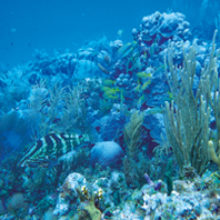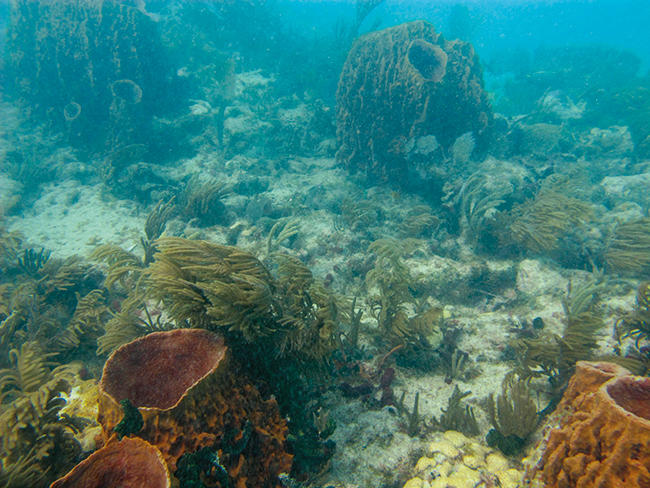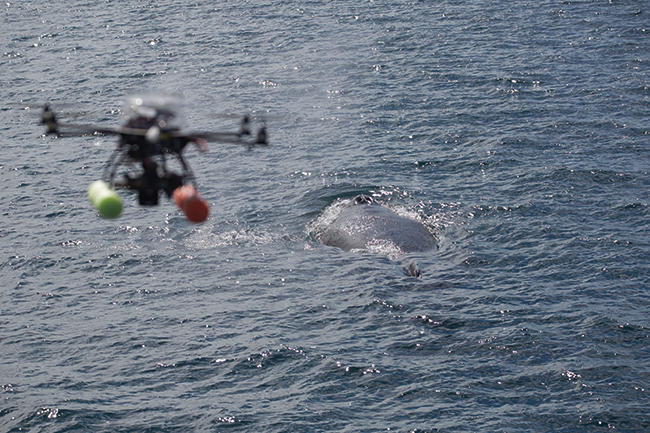Impact of conservation on ocean animal microbiomes
Issue: Oceans
05 February 2019 article

My elder coral reef colleagues frequently reminisce about the past state of Caribbean coral reefs. Their observations of coral reefs during the 1960s and 1970s include descriptions of abundant elkhorn corals, massive mounding star corals, and plentiful grouper and large-sized parrotfish. All of these features are now rare on most Caribbean reefs, which have been impacted by disease, overfishing and habitat destruction. Abundant and fast-growing macroalgae, smaller corals and fish of reduced size and numbers have replaced the prior keystone species.
As a microbial ecologist listening to descriptions of these past Caribbean reefscapes, I am intrigued by this change. I wonder if and how micro-organisms and their functional processes have altered during this period of dramatic transformation. Did the environmental microbes, including those in the reef waters and sediment, alter in composition? Have the microbiota of the animals altered in response to the pressures of this new environment? Finally, how do these microbial changes feed back into larger ecosystem and animal health changes?
Marine life conservation and microbiomes
It is these scenarios of ecosystem and species decline that have led to conservation efforts for many marine animals, including 10% of the coral species found only in the Caribbean. Conservation is the act of protecting and preserving resources, and it is important because it maintains biodiversity and balanced ecosystems, thus promoting their functioning and overall health. In the ocean, conservation protections are frequently placed on vulnerable marine life to prevent further exploitation and promote recovery of species. These protections are most commonly placed on life due to threats from overexploitation (for example, fishing and harvesting) and habitat degradation that is enhanced by coastal development. Currently, the International Union for Conservation of Nature (IUCN) lists 12,929 marine species on their Red List with 1,679 assigned a threatened or near-threatened status.

There is very little known about how conservation efforts impact the microbiota of marine animals because the microbiomes of most ocean animals are unstudied. Detailed studies do exist for some taxa, but they are generally not done in a manner that allows for direct comparison before and during/after a species is impacted by the aforementioned threats. While it is difficult to ‘go back in time’ for some marine animals, there are predicted to be around two million marine animal species in the oceans, and most of these are not thought to be in decline. Understanding the microbiomes of these healthy animals at the present time could enhance future conservation and management efforts.
Need for baseline microbiomes
The microbiomes of healthy, non-threatened marine animals can provide an understanding of their baseline or normal microbiomes. This is most cost-effectively examined using high-throughput sequencing of small subunit ribosomal RNA genes or other taxonomic marker genes, which provide data about the taxonomic composition of the associated micro-organisms. At a greater cost, metagenomic sequencing of all the DNA in an environment provides additional insight into functional genes of the micro-organisms, as well as cells that may not be accounted for by the primers applied to the marker gene studies.
These types of sequencing-based data are valuable and can provide a window into the micro-organisms associated with healthy or normal functioning animals. Studies of human microbiomes, and especially gut microbiomes, show clear connections between the diversity and composition of the microbiota and individual diet and health states. These microbiome baselines can be most informative when disease symptoms are present. As such, the healthy microbiome can be used to document changes, including noting the presence of potential pathogens or loss of beneficial micro-organisms. Gathering knowledge of the associated animal microbiome prior to, and following, animal health or habitat declines is a major challenge in this comparison. Indeed, under the current rate of climate-associated change impacting the ocean, it is difficult to attain true baselines on the microbiomes of non-impacted animals.
It is impossible to apply today’s deep-sequencing methods to the Caribbean reefs of the past, yet studies are taking creative approaches towards building an understanding of how conservation efforts can impact the microbiomes of marine animals. A recent three-year field experiment examined how overfishing and nutrient pollution, as well as natural temperature fluctuations, impacted the surface mucus microbiomes of coral. This elegant experiment demonstrated shifts in microbial community composition within the surface mucus layer of corals, following the stressors. Further, putative pathogens and observations of coral disease symptoms coincided with the ecosystem disturbances. This work provides a link between overfishing and nutrient pollution impacting coral microbiomes, and suggests that ecosystem conservation could also conserve the coral microbiome and decrease the susceptibility of corals to disease. My laboratory group, together with colleagues, is further examining this relationship through comparative studies of coral microbiomes sampled inside and outside of marine protected areas.

Ocean warming and pathogens
Ocean warming is directly related to animal microbiome composition in the ocean, including animals under conservation protection. This relationship has been observed in corals, sponges, oysters and even in microbiomes on the surfaces of whales. The specific mechanisms behind why community alterations occur have not been directly examined. There are at least two possible hypotheses driving this relationship. The first is that temperature is a major and controlling factor of microbial growth. Thus, enhanced temperature may select for the growth of certain micro-organisms. The second hypothesis is that enhanced temperatures, especially for prolonged periods, could impact immune and biochemical changes within the host, thus influencing the chemical growth or communication environment that is optimal for the microbes. Overall, ocean warming and altered microbiomes could impact the health and major functioning of ocean animals, especially if the microbes are endosymbionts or involved in an obligate relationship.
Another major concern for ocean animal microbiomes is that warmer sea conditions could promote the growth of pathogens and/or promote virulence of normally benign species. A 40-year ocean time- series recently demonstrated that warming oceans promote the growth and persistence of Vibrio, including pathogenic strains. Indeed, marine diseases have increased in prevalence over the past few decades. Some of these new outbreaks are not caused by new and emerging micro-organisms, but rather known pathogens infecting previously untargeted hosts. For example, many Caribbean sea fans are infected by the pathogen Aspergillus sydowii, which is a fungus inhabiting soils and known to infect terrestrial life.
Health diagnostics, probiotics and future prospects
A benefit of understanding the microbiome of an animal is that a framework is developed for health diagnostics. This health diagnostic approach could play a role in conservation efforts or management decisions. Towards this idea, my laboratory, along with colleagues, is examining the microbiota within skin, as well as within the exhaled breath or ‘blow’ from large whales. As large whale populations continue to face pressures from human use of the oceans, microbiome metrics could provide a means to document animal health alterations.
Intervention by probiotics is an emerging and controversial idea, which certainly benefits from extensive knowledge of ocean animal microbiomes. The idea behind probiotics is that supplements of beneficial micro-organisms are given to an animal, which will then enhance its health and/or recovery from disturbance. Human probiotics is a more than $40 billion industry, yet the scientific data demonstrating their benefits is still largely lacking. In conservation biology, especially for terrestrial animals, probiotics are viewed as potentially beneficial for captive-raised animals. In the ocean, research groups are examining the benefits of probiotics for aquaculture, as well as to improve coral resistance to disease following ocean warming-related and widespread bleaching events.
In animal conservation studies, surveys are commonly conducted to understand the number and distribution of species. Similar information is needed for the microbiomes of ocean animals. This knowledge could have powerful benefits for animal conservation in the oceans, and is especially pressing to obtain under the current and planned climate-related impacts facing the ocean.
Further reading
Apprill A. Marine animal microbiomes: toward understanding host–microbiome interactions in a changing ocean. Front Mar Sci 2017;4:222.
Apprill A, Miller CA, Moore MJ, Durban JW, Fearnbach H et al. Extensive core microbiome in drone-captured whale blow supports a framework for health monitoring. mSystems 2017;2:e00119–00117.
Bahrndorff S, Alemu T, Alemneh T, Lund Nielsen J. The microbiome of animals: implications for conservation biology. Int J Genomics 2016;2016:5304028.
Bodelier P. Toward understanding, managing, and protecting microbial ecosystems. Front Microbiol 2011;2:80.
Peixoto RS, Rosado PM, Leite DCdA, Rosado AS, Bourne DG. Beneficial microorganisms for corals (BMC): proposed mechanisms for coral health and resilience. Front Microbiol 2017;8:341.
Redford KH, Segre JA, Salafsky N, Del Rio CM, McAloose D. Conservation and the microbiome. Conserv Biol 2012;26: 195–197.
Smith GW, Ives LD, Nagelkerken IA, Ritchie KB. Caribbean sea-fan mortalities. Nature 1996; 383:487.
Vezzulli L, Brettar I, Pezzati E, Reid PC, Colwell RR et al. Long-term effects of ocean warming on the prokaryotic community: evidence from the vibrios. ISME J 2012;6:21.
Zaneveld JR, Burkepile DE, Shantz AA, Pritchard CE, McMinds R et al. Overfishing and nutrient pollution interact with temperature to disrupt coral reefs down to microbial scales. Nat Commun 2016;7:11833.

Amy Apprill
Associate Scientist, Marine Chemistry and Geochemistry Department, Woods Hole Oceanographic Institution, 266 Woods Hole Road, MS #4, Woods Hole, MA 02543, USA
[email protected]
www2.whoi.edu/site/amy-apprill
Twitter: @AmyApprill
Amy Apprill leads the Microbial Ecology for Ocean Conservation research laboratory at the Woods Hole Oceanographic Institution. Her laboratory conducts research which examines the contribution of micro-organisms to the health and ecology of sensitive animals and ecosystems of the ocean. She also partners with communication professionals to convey this science to public audiences.
What is the most rewarding part of your job?
The most rewarding part of my job is the time I spend in the field. I enjoy the beauty and tranquility that ocean ecosystems offer, the challenge of conducting research in remote locations and working together with a team of scientists.
What advice would you give to someone starting out in this field?
Don’t be afraid to ask for help or advice when you are stuck. Most of us have been in that same place many times and have counted on others for help identifying solutions.
Images 1 and 2: Recent photographs of Caribbean reefscapes provide a pictorial contrast of remote and protected reefs in the Gardens of the Queen, Cuba (above) and less protected and more impacted nearshore coral reefs in the Florida Keys, USA (below). Amy Apprill.
Image 3: A remotely operated hexacopter or drone approaches a humpback whale in the waters surrounding Patagonia, Chile. The drone holds a petri dish, which is used to collect exhaled breath or blow samples from large whales. These blow samples are being analysed to understand the composition of the associated microbiome. This technique is being explored as a means to non-invasively assess the respiratory health of whales. Courtesy of Daniel Casado (MERI) and taken under permit MERI 1197-Feb-2017.
